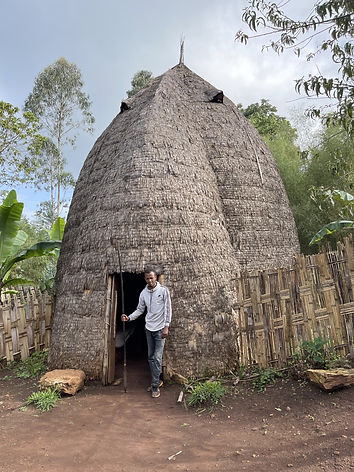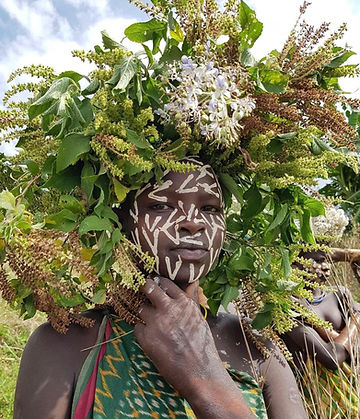ETHIOPIA: lalibela, rift valley & omo valley
Ethiopia fascinates us, a heady mixture of ancient and modern cultures and sights. Many of the ancient sites have been continuously occupied since their construction lending a timelessness to the country. The rock hewn churches of Lalibela, carved out underground from single solid piece of stone are a wonder to explore. The Rift Valley with its beautiful lakes and the Omo Valley, home to tribal people who still live traditional lives are like a page out of National Geographic Magazine from a century ago. There is so much in Ethiopia to make you say "wow." And while Ethiopia does not have the vast numbers of animals seen in some parts of Africa, it more than makes up for this with its varied and dramatic landscape, some of the most impressive and unusual seen anywhere in Africa. We travel in comfortable vehicles, take domestic flights and spend the nights in some of the best lodges and hotels Ethiopia has to offer.



DAY-BY-DAY ITINERARY
DAY 1: THURSDAY, JAN 9
Arrival
Arrive Addis Ababa, where you will be met by guide and driver and taken to hotel for check in and the chance to rest. Depending upon arrival time, you can either have day to rest or sightseeing with guide. Overnight at Best Western Plus Hotel.
(Lunch, Dinner)


DAY 2: FRIDAY, JAN 10
Addis Ababa to Lalibela
Morning 1-hour flight takes us from Addis Ababa to Lalibela. A UNESCO World Heritage site, and the home of 11 rock hewn monolithic churches constructed in the 12th century. Imagine excavating 4 stories down into the rocky ground and carving underground churches from single piece of stone. Access to the churches is via a maze of passageways and tunnels, and inside are intricately carved reliefs and astonishing icon paintings; yours to gaze upon and photograph. All 11 churches are still in use, as we explore them we meet priests, deacons, nuns and parishioners. Overnight at Sora Lodge.
(B,L,D)
DAY 3: SATURDAY, JAN 11
Lalibela
This morning we continue our exploration of Lalibela's churches in the company of our local guide. In the afternoon we have time to explore the center of town, visit handicrafts shops and enjoy an Ethiopian coffee ceremony. Overnight at Sora Lodge.
(B,L,D)
DAY 4: SUNDAY, JAN 12
Lalibela to Lake Bishoftu
We have early afternoon flight from Lalibela to Addis Ababa, where vehicles will be waiting to drive us to Lake Bishoftu. Only an hour away from Addis Ababa, Lake Bishoftu is a resort destination due to the beautiful lake and proximity to the capital. This is the first of several of Ethiopia's Rift Valley lakes we explore. Overnight at Kuriftu Resort.
(B,L,D)

.jpg)

DAY 5: MONDAY, JAN 13
Lake Bishoftu to Lake Langano
A morning 3-hour drive will take us though interesting landscape to arrive at lunch time at Lake Langano. All the Rift Valley lakes differ by mineral content to water, and Lake Langano has a chocolate colored look to it, contrasting to the green vegetation growing on its shores. Our hotel is located on the lake shore, and the rooms are bungalows set in acacia woodland with many interesting Ethiopian birds.
Overnight at Sabana Beach Resort.
(B,L,D)

DAY 6: TUESDAY, JAN 14
Lake Langano to Lake Hawassa
This morning we continue to drive south, with the town of Hawassa our destination. En route we stop at Abijatta-Shalla National Park. The park is home to the endangered Somali ostrich, which looks much like other ostrich, except the skin is blue and not pink. The ostrich live in semi captivity here, which makes it easy to observe them. Gazelle and monkeys are also commonly seen in the park.
After visiting the park, we stop on by Lake Ziway to see the many storks, pelicans and other birds that make this area their home and can be easily viewed.
Mid afternoon arrival at Lake Hawassa in time to enjoy sunset from the hotels gardens overlooking Lake Hawassa.
Overnight at Haile Resort-Hawassa.
(B,L,D)

DAY 7: WEDNESDAY, JAN 15
Lake Hawassa
This morning we visit the local fish market, where you can observe fishermen who catch a vast array of fish from the lake. The market is both interesting and colorful, making for great photo opportunities. Large marabou storks, prehistoric looking 4 foot birds patrol the market, looking for fish scraps to eat. Nearby is a forest reserve with many black and white colobus monkeys, an increasingly rare species of beautiful monkey easily observed here, making them great photography subjects. Next we explore the market in Hawassa.
Overnight at Haile Resort-Hawassa.
(B,L,D)



DAY 8: THURSDAY, JAN 16
Hawassa to Arba Minch
Today we have a 5-hour drive to the southern city of Arba Minch. The landscape grows increasingly lush as we move south, to arrive early afternoon at our hotel. This afternoon you can relax at the hotel and enjoy the sunset view of Lake Chamo and Lake Abaya from the hotel gardens..
Overnight at Haile Resort-Arba Minch
(B,L,D)


DAY 9: FRIDAY, JAN 17
Arba Minch, Lake Chamo excursion & Dorze village visit
A morning boat excursion to Lake Chamo provides the opportunity to see crocodiles, hippos, interesting bird life and spectacular scenery as both sides of the Rift Valley walls rise up above the glassy water of the lake. Return to hotel for lunch to relax, and late afternoon we visit the Dorze tribal village; the Dorze people are famed for their tall beehive shaped homes, built of bamboo and false banana leaves. Dorze men are excellent weavers and make beautiful items on the many looms seen in the village. Our visit to this village will be coordinated by local Dorze villagers who curate this unique welcome experience as they share food, tradition, entertainment and allow us to purchase some of their beautiful textiles.
Overnight at Haile Resort-Arba Minch.
(B,L,D)


DAY 10: SATURDAY, JAN 18
Arba Minch to Turmi
Today's drive takes us into the Omo Valley. The Omo was not part of Ethiopia until 1890 and is ethnically and geographically different from the rest of the country. One of the least visited parts of Ethiopia, it is also one of the most fascinating. Here we meet tribal people whose way of life has not changed much in the past 100 years. We meet these people in the company of our tribal friends who grew up living traditional lives, and now move easily between modern and traditional ways. In their company our welcome will be warm and we have the opportunity to observe a way of life unique and probably soon to disappear, as the forces of modern Ethiopia attempt to integrate these people into the fabric of the nation. Right or wrong is a topic of endless conversation and our local guides who themselves are the product of these cultures have their own take on this topic, there is much to see and plenty of food for thought in our Omo Valley visit. Overnight at Buska Lodge.
(B,L,D)

DAY 11: SUNDAY, JAN 19
Meet the Karo tribe
This morning we drive through beautiful savanna with many termite mounds that rise up to 20 feet high. It is said that the volume and weight of Africa's termites outweigh that of all other wildlife. The termite mounds are certainly impressive and the scenery along the way is home to antelope, monkeys and numerous birds. The Karo village is situated at a bend in the Omo River. Karo are known for their elaborate body paintings and for small fee you too can have your face or torso turned into a work of art by one of the local painters (not to worry, all natural materials are used and the paint easily washes off). Late afternoon excursion to visit Hamer tribe village near our hotel. Overnight at Buska Lodge.
(B,L,D)

DAY 12: MONDAY, JAN 20
Turmi to Omorate
After breakfast we drive south to the settlement of Omorate on the Omo River, and then cross the river by dugout canoe to visit the Dassanech tribe. Our local guide will introduce us to this people and explain their customs and traditions. The Dassenech were once entirely nomadic, but now live a more sedentary life, but their nomadic roots are visible in their impermanent looking homes. We return to Turmi for lunch and rest and then in afternoon take optional hike in nearby savanna. Overnight at Buska Lodge.
(B,L,D)

DAY 13: TUESDAY, JAN 21
Turmi to Jinka
Today we drive 4 hours to reach Jinka, stopping in the market town of Key Afer to see the local wares on display. This is not a tourist market, but offers items that locals use for for food and daily use. There are however some of the masks and jewelry used by locals for sale, so this can be good place to purchase some of the elaborate items that locals use to adorn themselves. Once arrived in Jinka we will visit the Aari tribe, subsistence farmers who grow vegetables and are famed for the quality of the honey they produce. Overnight at Nasa Pension.
(B,L,D)



DAY 14: WEDNESDAY, JAN 22
Excursion to Mursi village
The Mursi are the most striking of all the tribes in the Omo Valley. Starting at puberty the women insert disks in their lower lips, and ear lobes, plus both sexes scarify themselves in distinctive and unique designs. Their appearance is unusual and their nomadic way of life fascinating. We have as local guide a tribe member who has become a good friend of Champaca Journeys and with his introduction, our arrival is warm and we have a unique opportunity that many visitors do not have. We will be able to ask questions, have our faces painted, buy some of their goods and freely wander the village. Late afternoon visit to the small but excellently curated local ethnological museum. Overnight at Nasa Pension.
(B,L, D)
DAY 15: THURSDAY, JAN 23
Jinka to Addis Ababa
Today we return to Addis Ababa, an hour long flight from Jinka. We have time to relax in Addis before setting out for a farewell dinner and culture/dance show at the famed Yod Abysinnia Restaurant. Overnight at Best Western Plus Hotel.
(B,L,D)

DAY 16: FRIDAY, JAN 24
Departure
Time to relax until transfer to airport and onward flight. For those with late flights, guide and driver available for sightseeing.
(B)

PRICES & REGISTRATION INFORMATION
(Inclusive of food, non-alcoholic beverages, accommodations, airport transfers, ground transportation, entrance fees, services of licensed Ethiopian guide and driver, services of USA based trip leader, and airport taxes.)
$6300. (Based on double occupancy)
$7000. (Based on single occupancy)
NOTE: International airfare, gratuities, alcoholic beverages, laundry, souvenirs, items of a personal nature, travel insurance and Ethiopian visa are NOT included.
GENERAL INFORMATION
INTERNATIONAL AIRFARE
Participants are responsible for their own air transportation to Addis Ababa airport where the journey begins. Many airlines serve this airport, from North America, Europe and Asia, including ETHIOPIAN AIRLINES, a highly regarded carrier with high marks for both safety and service. Ethiopian Airlines is a member of the Star Alliance. The 3 internal flights on this journey are also with Ethiopian Airlines and are included in the cost of the journey IF you travel to Ethiopia with Ethiopian Airlines (if not there is a surcharge of $400).
Ethiopian visa is easily obtainable online for cost of $82.
For participants arriving before start of trip, or staying after final day we can arrange rooms in Best Western Plus Hotel. Cost is $135 for double occupancy, tax and breakfast included, and $100 for single occupancy, tax and breakfast included.
